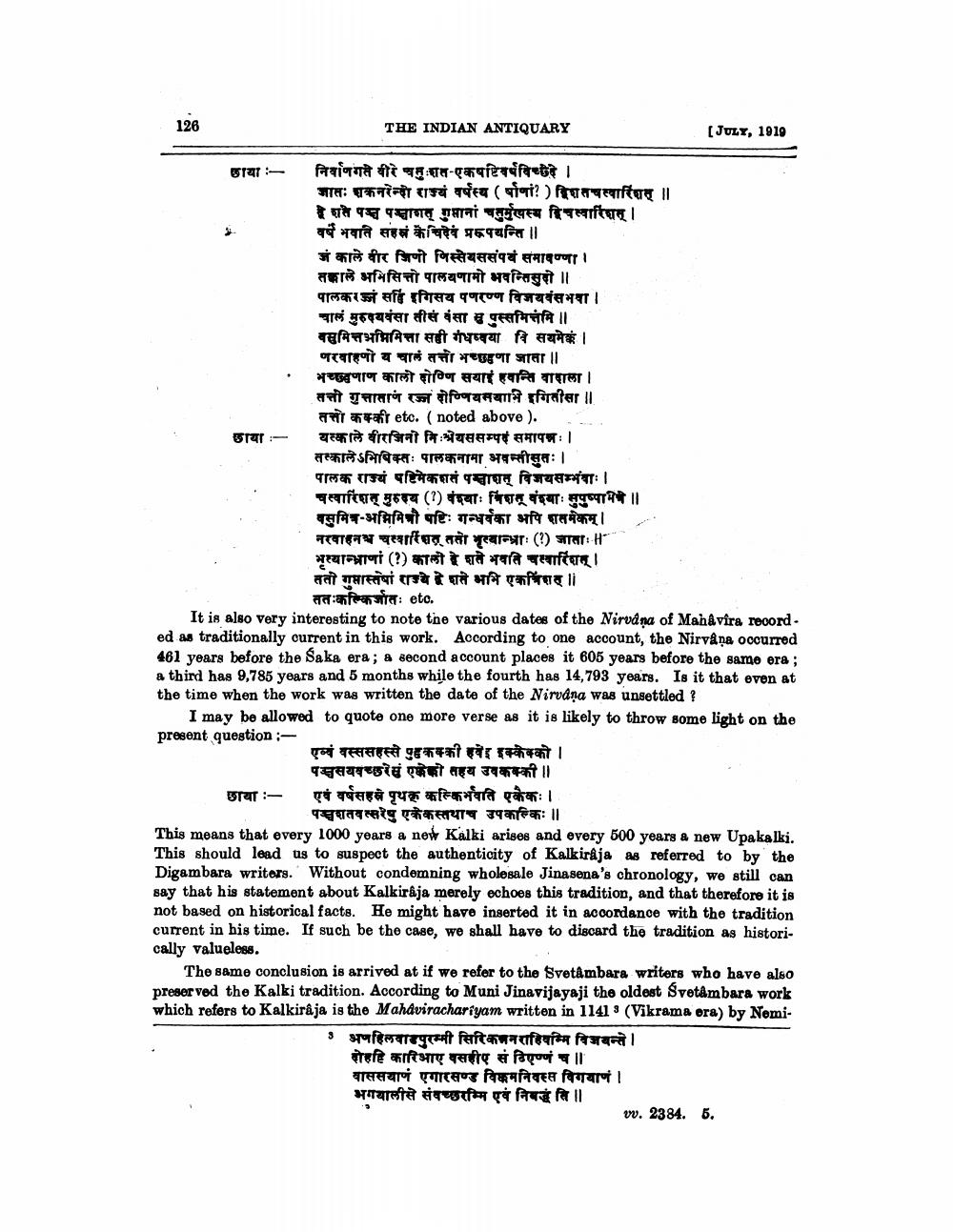________________
126
THE INDIAN ANTIQUARY
[JULY, 1919
छाया:
निर्वाणगते वीरे चतु:शत-एकषष्टिवर्षविच्छेदे । जातः शकनरेन्दो राज्यं वर्षस्थ (र्षाणां?) विशतचत्वारिंशत् ॥ है शते पञ्च पश्चाशत् गुप्तानां चतुर्मुखस्य विचल्वारिषत् । वर्षे भवति सहवं केचिदेवं प्ररूपयन्ति । जं काले वीर जिणी मिस्सयससंपवं समावण्णा। सकाले अभिसित्तो पालयणामो भवन्तिसुदो ॥ पालकरनं सरगिसब पणरण्ण विजयसभवा। चालं मुरुदयवंसा तीसं सास पुस्समिमि ॥ वसुमित्तभनिमित्ता सही गंधध्वया वि सयमेकं । परवाहणो व चालं तत्तो भच्छहणा जाता ।। भच्छवणाण कालो दोणि सयारहवन्ति वादाला। सत्तो गुत्ताताणं रज्ज दोषियमवाभि इगितीसा ।।
तत्सो कक्की etc. (noted above). छाया:- यस्काले वीरजिनी निःश्रेयससम्पद समापनः।
तत्कालेऽभिषिक्तः पालकनामा अवन्तीसुतः। पालक राज्यं पहिमेकशतं पश्चाशत् विजयसम्भवाः। चस्वारिंशत् मुरुत्य (?) वश्वाः शितू वंश्याः सुपुष्पाभो ॥ वसुमित्र-अमिमित्री पष्टिः गन्धर्वका अपि शसमेकम् । नरवाहनध चत्वारिंशत् ततो भस्वान्धाः (1) जाता। भृत्यान्ध्राणां (?) कालो हे शते भवति चस्वारिंशत् । ततो गुप्तास्तेषां राज्ये हे शते भाभि एकत्रिंशत् ॥
तत कल्किर्जातः etc. It is also very interesting to note the various dates of the Nirvana of Mahavira record ed as traditionally current in this work. According to one account, the Nirvana occurred 461 years before the saka era; a second account places it 605 years before the same era%3B a third has 9,785 years and 5 months while the fourth has 14,793 years. Is it that even at the time when the work was written the date of the Nirvana was unsettled ?
I may be allowed to quote one more verse as it is likely to throw some light on the present question :
एव्वं वस्ससहस्से पुहकक्की हवेइ इक्केक्को ।
पञ्चसयवच्छरेसुं एकेको सहय उवकक्की । छाया:- एवं वर्षसहले पृथक कल्किर्भवति एकैकः।।
पञ्चशतवत्सरेषु एकेकस्तथाच उपकल्किः ॥ This means that every 1000 years a new Kalki arises and every 500 years a new Upakalki. This should lead us to suspect the authenticity of Kalkirkja as referred to by the Digambara writers. Without condemning wholesale Jinasena's chronology, we still can say that his statement about Kalkirkja merely echoes this tradition, and that therefore it is not based on historical facts. He might have inserted it in accordance with the tradition current in his time. If such be the case, we shall have to discard the tradition as historically valueless.
The same conclusion is arrived at if we refer to the Svetâmbara writers who have also preserved the Kalki tradition. According to Muni Jinavijayaji the oldest Svetůmbara work which refers to Kalkiraja is the Mahavirachariyam written in 11413 (Vikrama ora) by Nemi
, अणहिलवानपुरम्मी सिरिकननराहिवम्मि विजबन्ते ।
दोहहि कारिआए वसहीए सं ठिएण्णं च ॥ वाससयाणं एगारसण्ड विकमनिवस्त विगवाणं | भगयालीसे संवच्छरम्मि एवं निबद्धं ति॥
vv. 2384. 6.




